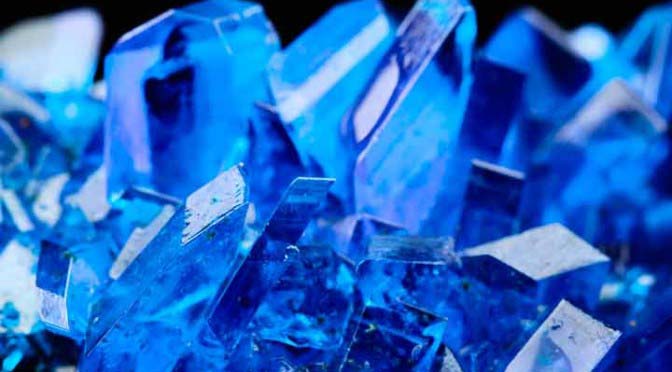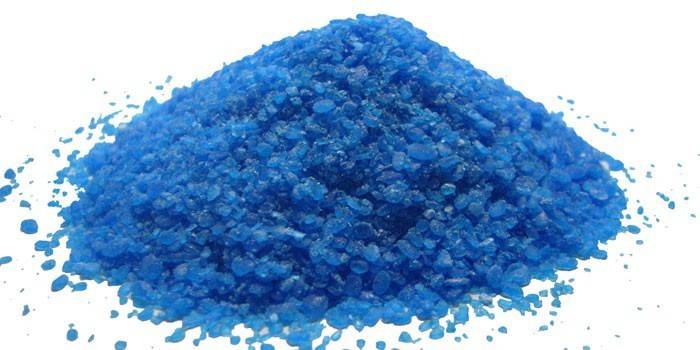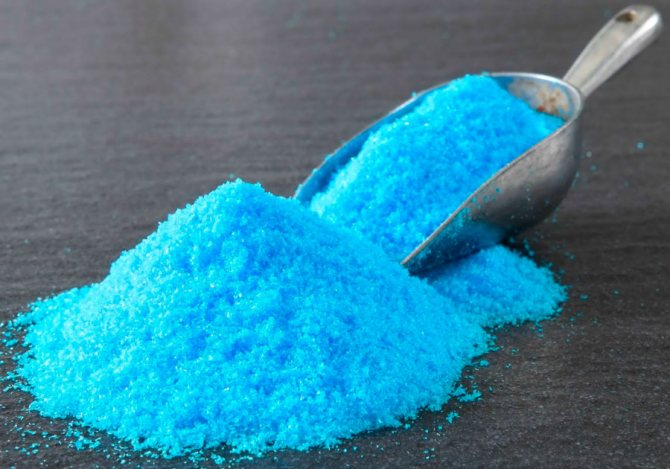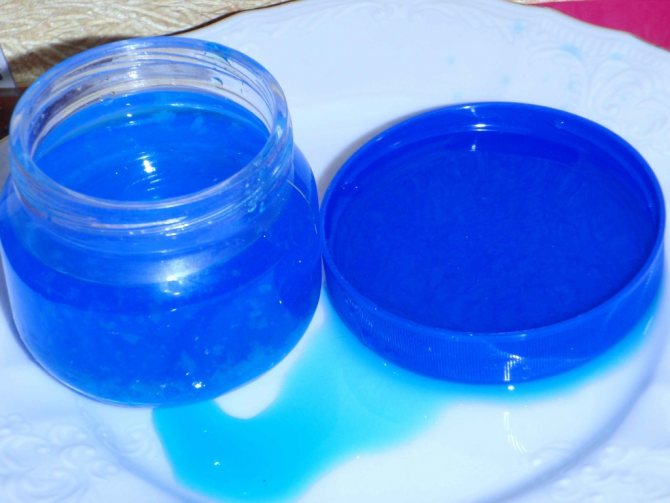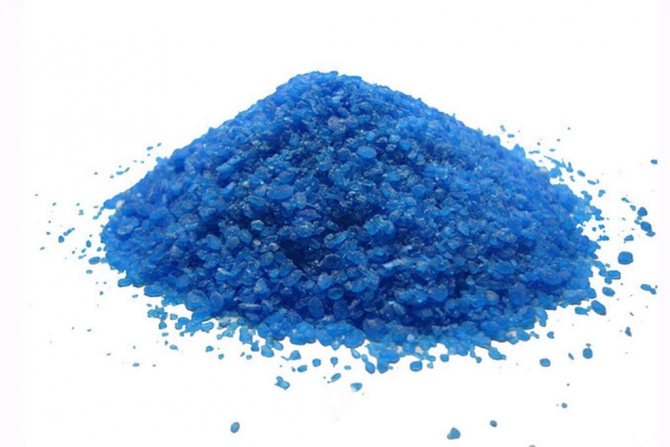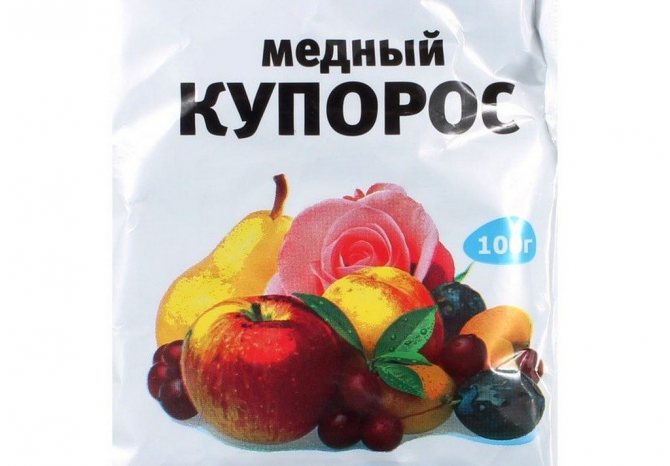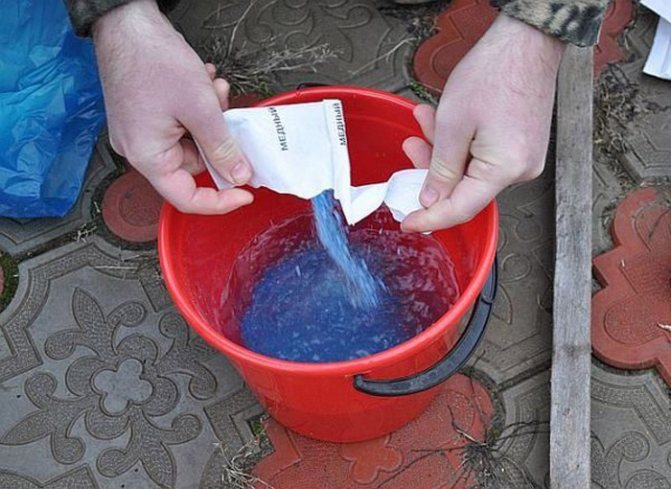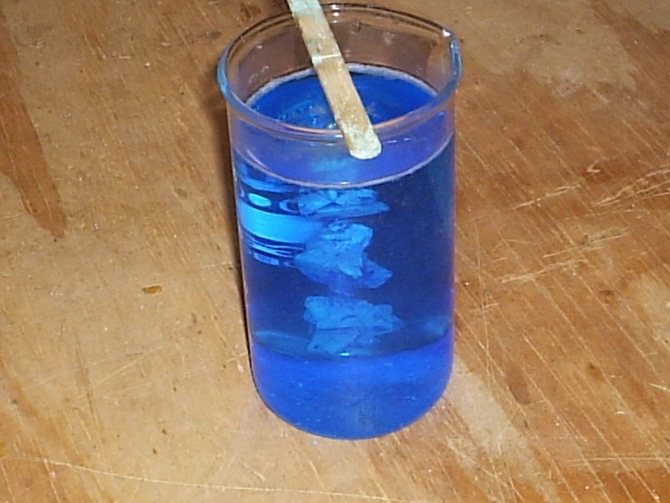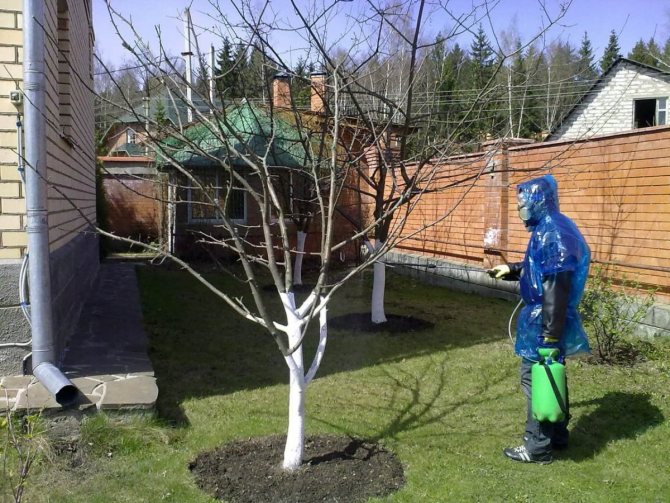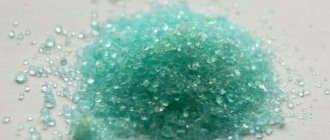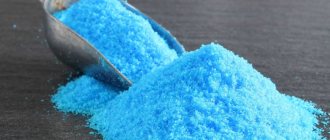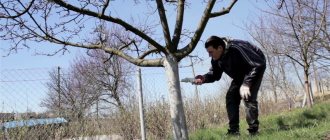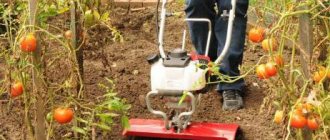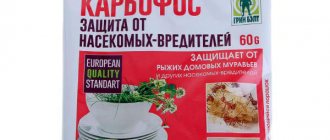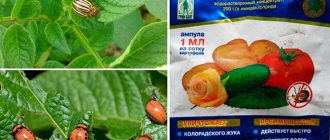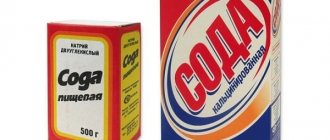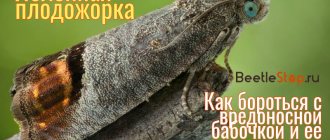Garden and horticultural crops are susceptible to various diseases that are caused by fungi, bacteria, viruses and insects. It is impossible to leave infected trees without treatment - this may kill the entire crop. Copper sulfate is one of the most popular and easy-to-use pest control products. It is sold in any agricultural store, and it is easy to prepare a solution at home, knowing what its concentration and dosage should be.
Copper sulfate - what is this substance?
Copper sulfate Is an active hygroscopic powder in the form of blue-blue crystals. It contains 980 g / kg of copper sulfate. In aqueous solution is he can protect trees, berries, grapes, vegetables and flowers from diseases for 30 days. After spraying, copper ions come into contact with a bacterial or fungal cell and inhibit lipoprotein and enzyme complexes in it. In this case, the protoplasm is irreversibly changed and nonspecific denaturation of proteins occurs.
In other words, copper sulfate for plants is 5-water sulfate of 2-valent copper - CuSO4x5H2O. This product should not be handled carelessly.
Important to remember! Copper sulfate powder is classified as hazardous chemicals of the 3rd class. It has a toxic effect when a person enters the mucous membranes or inside. The lethal dose of a 5% solution is 30-50 ml. If you do not take precautions when handling copper-containing fluid, it can penetrate the skin through the glands when sweat is reabsorbed.
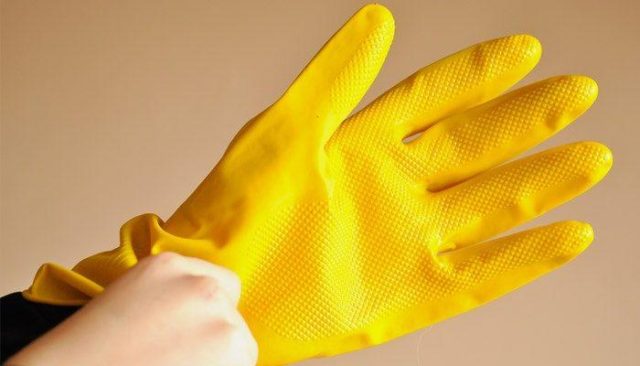
Correct use of the chemical does not lead to long-term undesirable and side effects, since it has no cumulative effect, but only biocidal and fungicidal... The substance is not resistant to harmful objects, that is, it is not addictive and does not increase their resistance, therefore the powder is often used to combat mold. In addition, Cu (II) ions are a copper-containing microfertilizer, which promotes the synthesis of phytohormones in plants.
How to properly dilute the agent for processing soil and different plants?
To achieve the best results and not ruin the garden, the copper sulfate solution must be properly prepared. For example, a concentrated liquid agent must be diluted with water according to the instructions, taking into account the type of garden culture, the problem being solved, the type of treatment. An incorrectly diluted remedy will not only not cure diseases, but it will also destroy seedlings and young growth in the garden, and may even harm a person.
Watering the soil: pros and cons
Agronomists argue whether it is necessary to water the soil with copper sulfate. If the land is fertile, not infected with fungi and pests, then you can do without such treatment. Soils with a high sand content, peat bogs contain little copper, so they need to be periodically fed with a useful trace element, which the plants will then absorb through the root system.


Where is copper sulfate used
What is liquid copper sulfate used for:
- to protect plants from such diseases, such as ascochitis, anthracnose, alternaria, moniliosis, clasterosporium, scab, coccomycosis, mildew of grapes, septoria or white spot, phyllostictosis, downy mildew, rust, curl, late blight and others;
- as foliar feeding with copper deficiency in plantings on soils: acidic sandy and peaty;
- for spring-summer soil disinfection, while solutions are not used before winter in order to exclude soil oversaturation with copper ions;
- for wooden structures as an antiseptic against rot and mold.
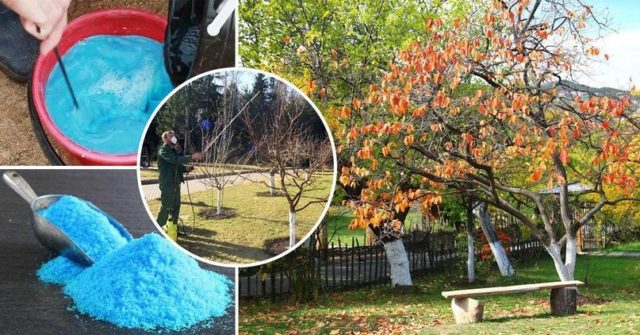

Chemical dilution
How to prepare a 1% liquid copper sulfate solution:
- for 10 liters of liquid - 100 g;
- for 1 liter of liquid - 10 g.
First, you need to dilute the powder for the working solution in 500-700 ml of heated water up to 40-50 ° C in a plastic bucket. After dissolving the copper sulfate, the rest of the water is added.
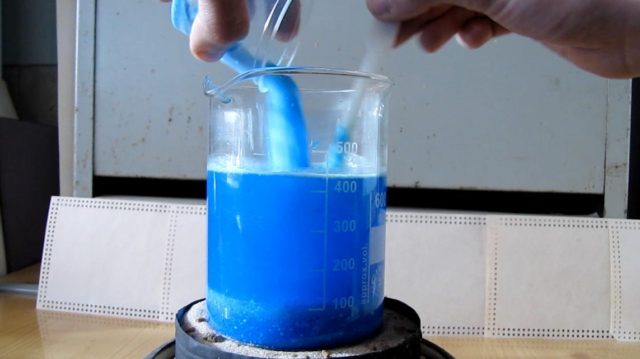

Important. Do not use metal buckets, and the solution should be filtered through a nylon filter before pouring into the sprayer.
Each season provides for different purposes for processing plants, since copper sulfate can be diluted with a concentration of 3 degrees. Prepare a solution:
- Scorching - 3-5% preparation: water - 10 l, powder - 300-500 g. The mixture is used to disinfect the soil on the site or fight mold on building structures. The land is taken out of agricultural use for 12 months after cultivation.
- Treatment-and-prophylactic - 0.5-1%. Add 50-100 g of powder to 10 liters of water. Spray and treat wounds on trunks and branches, destroy fungi and insect pests, as indicated above.
- Fertilizing and prophylactic - 0.2-0.3%. For 10 liters of water - 2-3 g of powder. The treatment is used for symptoms of copper starvation: leaf chlorosis, twisting of the tips of the shoots, intensive tillering without shoot growth and for the sake of prevention.
From the prepared 10% masterbatch, you can dilute the solutions specified in paragraphs. 2 and 3. The masterbatch can be stored for a long time in a dark place in a container with a well and tightly closed lid.
Bordeaux liquid
If copper sulfate is dissolved in water with lime, you get a Bordeaux liquid. They sell a 3% mixture of chemicals in ready-made packages, where copper sulfate is 300 g and lime - 400 g. To dilute a 1% concentration, you will need 100 g of each component. Copper in the mixture plays the role of poison, and lime acts as a neutralizer. The solution is used immediately after dilution, if it is stored for a day, then add sugar to a 10-liter bucket with a mixture of sugar - 5 g.
They are treated with Bordeaux liquid (3%) once before the buds appear, 3-4 times during the growing season (1%). The period of validity of the liquid is 10-14 days, at the end of which the subsequent processing begins.


The mixture is spent on plants in the following quantities:
- on fruit and berry trees, deciduous and coniferous trees, large shrubs - 15-20 l / 100 m²;
- for medium shrubs and grapes - 10-15 l / 100 m²;
- for small bushes: potatoes, strawberries - 5-10 l / 100 m²;
- on large trees with external signs of fungi - 10-15 liters of the mixture (1%) per tree.
With the help of Bordeaux liquid, you can treat and prevent diseases of various plants and improve the garden area and vegetable beds.
Methods for using vitriol in spring


The use of the drug in the country is possible in a variety of variations and at very different times of the year. Spring treatment consists of the following popular treatments:
- for spraying trees with copper sulfate, a 1% solution is used. You must do this before the first leaves appear;
- copper sulfate in horticulture can be used in other ways. In particular, the same 1% solution is used to treat the roots before planting. For this, the underground part of the seedlings is dipped into the prepared mixture for one minute, and then washed in running water or soaked in three waters for several minutes each;
- seeds of vegetables and other crops are disinfected with a 2% solution. The same composition is used to treat potato tubers before planting.
- for processing the soil with copper sulfate, a 2 - 5% solution is used. Consumption depending on the area of the site. On average, 1 sq. m takes 10 liters of the mixture. Such processing can be carried out in the fall.
How to apply solutions in the garden and indoors
Instructions for use in the garden of copper sulfate:
- Disinfects open ground or soil in a greenhouse 8-10 days before planting seedlings or seeds with a 3% solution: for 1 liter of water - 30 g of powder. This remedy can protect potatoes from late blight.
- Fleshy root system of tuberous plants or the bulbs are placed in a 1% mixture for 3 minutes, then washed and dried in air.
- Houseplants protect against disease sky blue solution: take 1 tsp for 2 liters of water. powder without a slide. The mixture is poured under the root or sprayed with leaves.
- Apple trees, pears, quince. The treatment of pome trees with copper sulphate is carried out with phyllosticosis and other spotting, scab, moniliosis, and drying out. For 10 liters of liquid - 100 g of the drug. For the first time, trees are treated before bud break and spend on 1 tree - 2-5 liters of the mixture. Repeat the treatment half a month before harvesting.
Copper sulphate for stone fruit trees is bred for treatment with clasterosporosis, coccomycosis and other spots, moniliosis, curliness of leaves with a solution: water - 10 l, powder - 50-75 g. The first time is sprayed in early spring before bud break and spend on a tree - 2-3 l of the mixture.
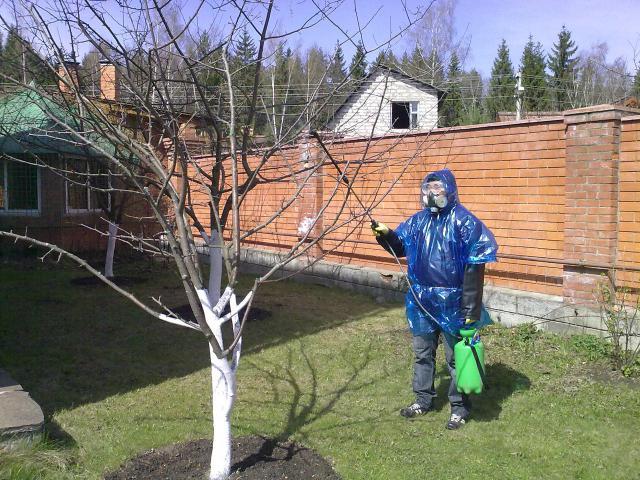

All types of currants and gooseberries are sprayed for the first time in early spring before bud break and spend on a bush - 1.5 liters of the mixture: water 10 liters, powder - 50-75 g.
Vegetable processing:
- Potato tubers before planting placed in a grid and dipped against late blight in such a solution: for 10 liters of water - 2 g of powder.
- Vegetables are sprayed when spotting appears, for example, on cucumbers (ascochitis) with a 0.5% solution of urea (10 g) and vitriol (5 g) in water - 10 liters. Spray 2 times at intervals of 7-8 days.
- Melons and gourds: pumpkins, zucchini, melons, watermelons, cucumbers are sprayed 5 days before harvest.
In order to prevent root rot in melons and gourds, which can be seen by the withering of the bushes on hot days, yellowing of the leaves, the death of the ovaries, the stopping of the growth of seedlings, you need to treat the bushes with the following solution: add 1 tsp to 10 liters of water. copper sulfate, zinc sulfate and 1 tbsp. l. superphosphate. Use a freshly prepared mortar at the rate of 5 l / m² of soil. Save vegetables and flowers from black leg and fusarium with a solution: water - 10 l, preparation - 5 g.
About tomatoes
Tomatoes suffer from late blight, but their leaves are sensitive to copper. To avoid burns, a 0.2% solution of a copper-soap emulsion is needed: grated laundry soap is mixed - 200 g, with hot water, copper sulfate is separately diluted in a glass jar - 20 g and stirred with a wooden spoon. This fungicide is poured into a soap solution and water is added to 10 liters.


Processing scheme: first, seedlings are processed, then seedlings 7-8 days after planting in a greenhouse or open field. During the dry season, tomatoes are not sprayed with a copper-containing mixture, but are treated with Fitosporin. After a cold snap in August, they are treated with the above mixture. During a damp and cool summer, the mixture is treated every 10-12 days in calm weather without wind. At the same time, they try to moisten the tomato leaves from the back side. If there are symptoms of late blight, then a week before picking tomatoes, the plant can be sprayed, and then rinsed well before eating.
It's important to know. Raspberries, strawberries, ripe apricots, peaches with soft and cracked skin, grapes, soft currant berries are sprayed 45 days before harvest, since these crops cannot be rinsed well with water before eating.Once they are processed until the flowering phase, the second - along the ovary.
When processing is carried out
Spring works
The treatment of plants with copper sulfate in spring is carried out with a therapeutic and prophylactic purpose, when:
- The air temperature will be stable - above 5 ° C, and will not decrease. The soil is treated with a 0.5% solution - 3.5-4 l / m² in order to prevent fusarium (yellowness) of root crops, in tomatoes - white and gray rot, in cabbage - a black leg.
- Before the buds of fruit plants bloom, in order to prevent the diseases of black cancer and fruit rot mentioned above.
- Treat with 1% solution.
- Before planting the seedlings, the root system is dipped in a 1% mixture for 3 minutes, then washed abundantly with water. In the absence of running water or if there is not enough water in the containers, the roots are intensively rinsed for 3-5 minutes in 3 containers with water in turn.
- Before planting potatoes, tubers are dipped or sprayed in a 0.2% solution to prevent late blight.
- Before planting cucumbers, the seeds are soaked in a warm mixture - 0.2% for 8-10 hours, other seeds - for 20-24 hours for early germination of seedlings.
- Before planting tomatoes and pumpkin plants, in order to exclude "hereditary" diseases, prepare a mixture in 10 liters of water, adding: copper sulphate - 1 g, boric acid - 2 g, potassium permanganate - 10 g. Soak the seeds in a lukewarm solution for 15 minutes, then washed with running water. If there is no running water, then 5 times new water is poured into the container with seeds and mixed well.


Summer works
Fruit trees and shrubs are sprayed with a 0.5-1% mixture for the symptoms of the above diseases. Wounds on the trunks are treated with a 1% mixture for trees, and with a 0.5% mixture for shrubs. Tomatoes and potatoes are processed with copper starvation and signs of late blight. Prepare a 0.2% solution and consume 2-3 l / m². After 15-30 days, the treatment is repeated.
Important. During the flowering phase, copper sulfate is not used for spraying.
Autumn works
For preventive purposes, in the fall, after leaf fall, plants are treated with copper sulfate (1%). At the same time, free sulfuric acid gets on the plant from copper sulfate, but there will be no chemical burns in the absence of leaves, flowers and fruits. In addition, there is no penetration of copper sulfate into plant tissues. Only fungal sporangia are affected without the drug entering their mycelium. By the beginning of the new growing season after the autumn treatment, the plants will receive copper and will be protected from diseases. For symptoms of powdery mildew and black spot on plants and flowers, they are treated with a 0.5% mixture.
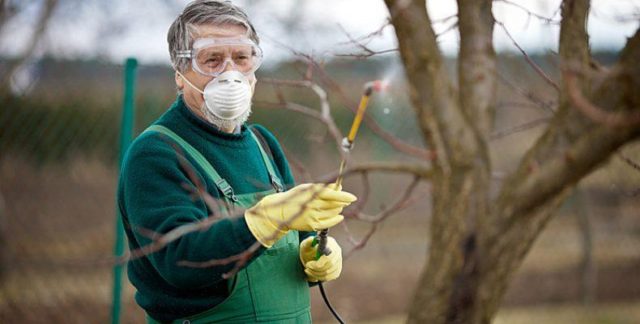

Important. In any season, plants are treated with copper preparations in the morning or evening in calm weather and in the absence of rain. The air temperature should be 5-30 ° C.
Trees can be protected from pests and fungi by whitewashing the trunks with a mixture of lime and copper sulfate or methyl blue.
Precautions
Since the antiseptic is a strong chemical, you should wash your hands, rinse your mouth and wash your face after spraying.
The tool will not cause colossal harm, but it is better to be warned against unnecessary troubles.
If, nevertheless, the harm was caused by the substance, then this can be understood by such signs as:
- nausea, vomiting;
- heart palpitations;
- weakness;
- stomach pain;
- itching, rashes, redness on the skin.
Based on the foregoing, we can conclude that copper sulfate causes harm not only to parasites, but also to humans.
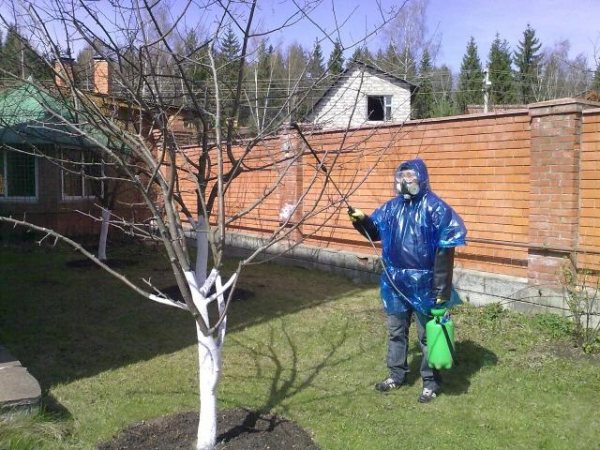

Observe safety rules when working
But in order to get poisoned with this substance, you need to spend a fairly long amount of time in contact with it.
Therefore, to process wood with copper sulfate, the following protection of the human body will be required:
We hope this information was useful to you!
Comments (1)
Inga 09/14/2018 at 10:41
An article about COPPER vitriol or IRON? ** Iron vitriol has available "soluble" iron, which saturates the leaves and the whole plant with useful elements. Fruiting fruit trees are especially iron deficient. Therefore, if a gardener finds an old iron object on his site, then he is in no hurry to throw it away - he puts it nearby or buries it near the trunk of a tree. **
Other uses of copper preparations
As a fertilizer, copper sulfate is applied to poor soils: sandy and sandy loam. In early spring or autumn, 1 g of copper sulfate is applied to 1 m² every 5-6 years. In case of copper deficiency, foliar top dressing is carried out with the drug - 1-2 g / 10 l of water.
In hotbeds and greenhouses, in cellars, in sheds, gazebos, wooden walls and flooring are treated, as well as fences with a copper-containing solution. It acts as an antiseptic if surfaces are sprayed, brushed or sponged. After the surface is dry, the treatment is repeated 1-2 more times. Such work is carried out every 3-4 months.
Prompt. Protection will be more effective if clay is added to the solution and the bearing posts of the fence, the support beams of the greenhouses, the porch of the house on the territory of the summer cottage are treated with this mixture. It is necessary not to allow the mold to penetrate deeply into the tree, otherwise it cannot be destroyed and removed.
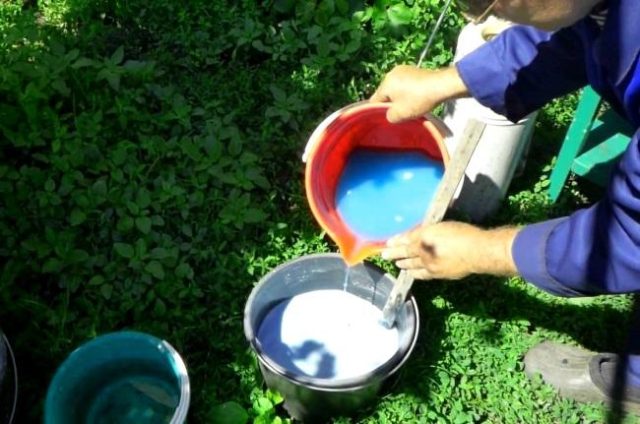

Application area
The demand for copper sulfate is due to a wide range of applications, usually a person uses it in the following areas of activity:
- Various types of industry, primarily metallurgicalwhere it is actively used in electroplating.
- Food industry, occurs as one of the main preservatives.
- Processing of various surfaces and productsthat require a shiny nickel layer.
- Chemistry, where it is used as an element that is a raw material, designed to obtain a number of independent compounds.
- Analysis of non-ferrous metals allows you to be able to identify the degree of content certain metals in various alloys of the aluminum type.
- Construction of buildings or any kind of renovation work in the premises first of all, it allows you to destroy and prevent the reappearance of mold and other fungal formations.
- Treatment of wood surfaces to make them fire resistant and preventing possible rotting under the influence of environmental conditions.
- As one of the components of some types of paints.
- Traditional and official medicine, where it is used in various forms as an antiseptic, a cauterizing agent, a drug for combating fungal diseases or a solution that helps with acute poisoning with certain substances with increased toxicity, for example, white phosphorus.
- Animal husbandry where it is used as a nutritional supplement, which is present in some compound feeds for farm animal breeds.
- Agricultural activities, horticulture and plant growing, in these areas, copper sulfate is most widespread, as a means that allows you to destroy most varieties of fungi and fight various parasites and pests.
Safety regulations
The copper-containing preparation is toxic to some extent for bees and humans. The bees are isolated during the garden processing period for 5-20 hours. Subject to dosages, phytotoxicity does not occur.
The security measures are as follows:
- Do not process the garden in the presence of children and pets.
- Use glasses to avoid splashes of the drug on the mucous membranes of the eyes.
- Work with gloves so that the mixture does not come into contact with the skin.
- Do not drink, smoke or eat while spraying.
- Residual mortar must not be discharged into drainage systems and sewerage systems.
- To prepare the solution, use glass or plastic dishes and mark it so that you do not accidentally put food in it.
- Metal enamel cookware is not suitable as the mixture will corrode the enamel.
Important. If the solution enters the gastrointestinal tract and vomits, they immediately call an ambulance and do not take any funds on their own. Water with potassium permanganate to induce vomiting will only aggravate the condition. If the mixture gets into the eyes, they are washed with running water several times.
You cannot prepare mixtures in your own kitchen, since room air temperature affects the sulfite impurities, as a result of which the solution will turn out cloudy. It will take 30 or more days to defend it and isolate the sediment.
Toxicity
Copper sulfate has a hazard class 3 for humans (it can cause serious irritation of the mucous membrane when in contact with a preparation or solution) and a hazard class 3 for bees (border protection zone for bees 4-5 km). The drug is low-toxic for bees, however, it is better to isolate the bees for the period of treatment of crops and in the next 5-20 hours. Not phytotoxic if dosage is not exceeded.
Security measures
Perform processing using gloves and glasses, avoid smoking, drinking, eating during work. In case of contact with the skin or mucous membranes, wash off with plenty of water, if it enters the digestive tract, vomiting usually occurs immediately, you can not take any funds, immediately call an ambulance.
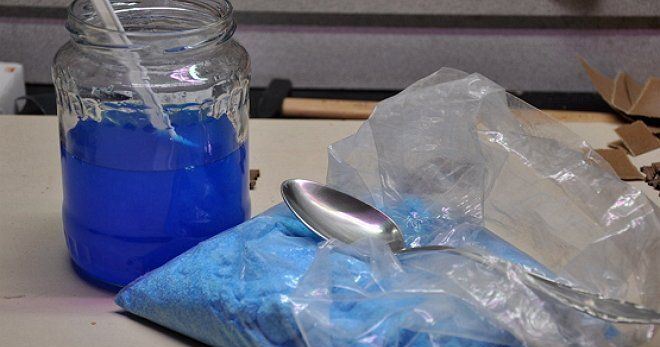

Any gardener dreams of an excellent harvest of healthy, robust vegetables and fruits. Copper sulphate - the use of which in gardening has already proven itself well, a well-known fungicide that kills pathogenic fungi and microflora. It has been used in vegetable gardens and orchards for over 100 years.


